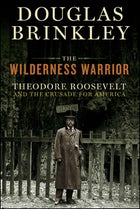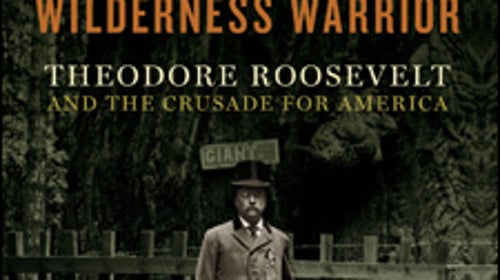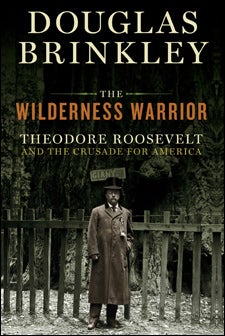IN ONE OF THE MOST memorable sections of The Wilderness Warrior: Theodore Roosevelt and the Crusade for America (HarperCollins, $35), the 26th president makes his first visit to Yosemite National Park with Sierra Club founder John Muir as his guide. Traveling on horseback in 1903the East Coast aristocrat Roosevelt playing cowboy, as usual, in a Stetson and jodhpurs; scraggly-bearded Muir “looking rather like a hobo who had been cleaned up for a photo”the pair spent three days camping and bonding. “Lying out at night under the giant sequoias had been like lying in a temple built by no hand of man,” Roosevelt would later write. Within hours of leaving Yosemite, he telegraphed his Interior secretary, Ethan Hitchcock, and ordered protected status for a larger swath of California’s great redwood groves.
REQUIRED READING
Over the course of a year in Montana’s Yaak Valley, Rick Bass meditates on the necessity of wildfire, the pleasures of duck hunting, and the utility of duct tape in The Wild Marsh: Four Seasons at Home in Montana (Houghton Mifflin, ). The book will slow you downin a good way.Novelist Ron Carlson turns Wyoming’s quiet Wind River Range into a human hunting ground for chilly lovers and colder meth dealers in The Signal (Viking, ).
In The Wauchula Woods Accord: Towards a New Understanding of Animals (Scribner, ), Charles Siebert reports on the spiritual similarities between humans and apes. By the time the science writer finds his simian soulmate in a Florida ape-rehab center, you’ll see the monkey in yourself.
And in An Irr…
The Wilderness Warrior
 The Wilderness Warrior
The Wilderness WarriorThat’s how T.R. rolled: Close encounters with new landscapes drove the Harvard-trained naturalist and fanatical fair-chase hunter to save wildernesses for future generations. And save them he did. While in the Oval Office, from 1901 to 1909, Roosevelt protected some 230 million acres of America’s wildlandsfive times more than all previous presidents combined. Often ignoring Congress and demands from railroad, oil, and timber bigwigs, he created 150 national forests, five national parks, and 18 national monuments. In this brick-thick, rather reverent biography, Brinkley, a historian and bestselling author (Tour of Duty, The Great Deluge), gives us the most insightful account yet of Roosevelt’s evolution from sickly, bird-nest-collecting schoolboy to the biggest, baddest conservationist of the 20th century.
Brinkley spends just a paragraph or two on events that might merit full chapters in a typical biographyRoosevelt’s 1906 Nobel Peace Prize, for example. Instead the author hones in on (mostly compelling) details about the people and experiences that made T.R. the naturalist tick. At an age when today’s kids are still into SpongeBob, young “Teedie” was asking his parents questions about the theory of evolution. Darwin became Roosevelt’s guru; as an adult, he often carried The Origin of Species in his saddlebag. But as we might have suspected, the thing that really cemented T.R.’s obsession with conservation was old-fashioned adventureespecially if it involved firearms. Brinkley vividly describes his many exploits, from a “cougar-collecting” trip in the Colorado Rockies to a wolf hunt in Oklahoma, where the energetic president was saddened by the absence of buffalo. He soon launched a reintroduction program.
Of course, Roosevelt’s modus operandi was not simply to protect and preserve. His enthusiasm for the “wise use” policies of Forest Service chief Gifford Pinchot irked preservation purists like Muir; his bloodlust has tarnished his conservationist image in some circles; and his push for numerous western reclamation projects, such as Arizona’s Theodore Roosevelt Dam, hasn’t won him any points with modern enviros. But Brinkley defends Roosevelt’s legacy, painting him as a well-meaning, complex charactera dyed-in-the-wool-hunting-breeches Darwinian who truly loved nature but was also hell-bent on conquering it. Did he play up the gun-toting, Wild West persona to offset his aristocratic upbringing? Partly, but so what? T.R. left us with one of the most progressive wilderness-protection systems in the world. Even readers who skim over the particulars of yet another hunting expedition will close this book with a better appreciation for Roosevelt’s forward-thinking geniusand, just as satisfying, the history of the American conservation movement in its formative years.
The Summit of the Gods
Mount Everest makes its graphic-novel debut.
EVEREST IS WHAT showbiz types call a “multi-hyphenate”: a big, profitable rock with crossover appeal on bookstore shelves, Imax screens, and TiVo queues. Add graphic novels to the list with this month’s new English translation of the Japanese manga work The Summit of the Gods (Fanfare, $25). It’s a five-volume, 1,500-page epic of mountaineering noir, an illustrated take on an award-winning Japanese novel, Kamigami no Itadaki, about an Everest climber who discovers what may be Mallory and Irvine’s legendary lost camera. Summit has been big in Japan for close to a decade, thanks largely to the huge adventure cachet of artist Jiro Taniguchi, whose comic oeuvre includes adaptations of Jack London stories and the journals of hunter and naturalist Ernest Thompson Seton. The first, 300-page volume hits Amazon and your local comic shop in July, and arts publisher Fanfare plans to release the next four installments quarterly. Reading right to left, Japanese style, takes a few pages to master, but the story is engrossing in a strange, Krakauer-meets-Kafka kind of way: Taniguchi’s black-and-white panels ooze existential anxiety as a crew of haunted climbers face down their demons at 26,000 feet and grapple with thugs trying to steal the prized camera in Kathmandu’s back alleys. Think of The Summit of the Gods as a Watchmen for rock jocksall the gritty tension and high-adrenaline heroics, but, thankfully, fewer glowing blue butt shots.
Five Top Twitters
The new yardstick of an athlete's cultural relevance? His following on the rapid-fire social-networking site Twitter. Here's how our favorite stars stack up.
LANCE ARMSTRONG
743,461
Typical post: Was winning the Tour seven times that offensive?!?
MICHAEL PHELPS
124,044
Typical post: Russell Brand on Twitter now! LOL – @rustyrockets. You are by far one of the funniest guys I’ve seen!! Lol
SHAUN WHITE
15,526
Typical post: Konichiwa! Quarterpipe down…here comes Big Air! What day is it again?
ROZ SAVAGE
5,093
Typical post: I used to relate to Tom Hanks’s role in Cast Away. But now it is The Terminal. Or Sleepless in Seattle.
STEPH DAVIS
679
Typical post: Pretty strange wingsuit flight, pure white clouds from 8000 feet to 5500. Had to use homing pigeon navigation to get back to the airport.




